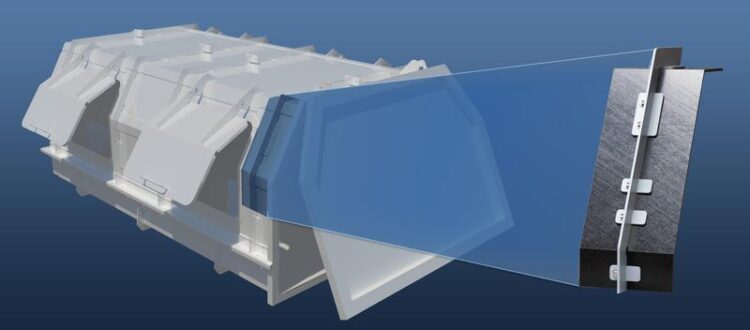Light e-waste runabouts for cities

Constructive concept of a container superstructure for a municipal waste collector in alternative mixed construction based on aluminum profiles and composite panels.
© EBF Dresden/Fraunhofer IWS Dresden
How optimally joined aluminum and fiber composite plastics contribute to climate protection
In order to improve city air quality and protect the environment, many municipalities are planning to acquire electric refuse vehicles for their parks and pedestrian passages. However, these are equipped with heavy batteries or fuel cells and can therefore usually transport less waste than classic waste trucks with combustion engines. However, German engineers now intend to change this by using lightweight designs. To this end, the Fraunhofer Institute for Material and Beam Technology IWS Dresden is developing innovative joining guns.
Six Central German research institutes and companies have joined forces for this project in the “UTILITAS“ (“Ultralight structures for commercial vehicles in municipal service operations“) network. Together, they aim at constructing better collection containers made of light metals and fiber composite plastics, which will replace the heavy steel superstructures of classic waste trucks and are about one third lighter.
“This new generation of electric vehicles would then be able to transport as much waste per load as a classic small waste truck, “ emphasizes Annett Klotzbach, who heads the Bonding and Fiber Composite Technology group at Fraunhofer IWS Dresden.
Profitable small series and simple repairs required
UTILITAS aims at sustainable and cost-effective solutions supporting municipalities to meet their climate protection goals with locally available resources. “This is why the alliance is developing not only the container, but also the related practical production technologies, “ explains the engineer. “The important point here is to ensure that the new containers can also be built profitably in small series and be quickly repaired in local workshops“. The project partners are relying on container constructions made of aluminum frames and fiber glass reinforced thermoplastic panels. They are testing various methods to reliably join these materials, comparable to steel constructions: They press, screw and glue, to name just a few.
With laser, heat and cold: Innovative HPCI® joining process development
The novel joining technology “HeatPressCool-integrative“ (HPCI®) developed at Fraunhofer IWS is additionally being employed: A laser first roughens the aluminum components, thereby creating grooves in the metal, thinner than a pin and only about 200 micrometers deep. Subsequently, the tool presses the plastic component against the aluminum strut and briefly heats the metal. During this process, the thermoplastic melts on the aluminum surface, flows into the laser-molded grooves and is anchored there during cooling. After a few seconds, aluminum and composite plastic are permanently and firmly bonded.
In the course of the development cooperation, the IWS engineers aim at determining exactly the long-term durability of such a joined lightweight container compared to screw or adhesive solutions. The container will have to withstand high loads in daily use, for example when the vehicle mechanics compress the collected waste. In previous experiments, the HPCI®-joined containers proved to be particularly durable and above all much easier to repair than glued constructions. Measurements have shown that the HPCI® joints can withstand tensile forces equivalent to the pressure of a hydraulic arm of up to 25 megapascals.
Spin-off to produce new joining guns in series
The IWS experts are convinced that the new joining process is not only suitable for waste container constructions, but also for lightweight constructions in aircraft, railways, industrial facilities or ships. Industrial customers also intend to use HPCI® in the production of dishwashers and other household appliances. In order to support the broad practical application of their new joining technology, the Dresden researchers have meanwhile developed compact HPCI® joining guns that are hardly larger than a standard hand drill. They can be modularly mounted on robots, for example, in order to quickly start a small lightweight production run. Since this new tool is so promising, the Fraunhofer scientists also intend to set up a company soon that will series-produce the HPCI® joining guns.
The first electric waste trucks with new lightweight containers will soon shape the urban scene – and the soundscape – of many large cities. “The container prototypes should be ready by beginning of 2021, “ announces Annett Klotzbach. “We expect the first waste collection vehicles to be on the road within two years. “ The developers envisage municipal companies as the main customers.
Six partners are involved in the “UTILITAS“ project: Fraunhofer IWS Dresden, the Chair for Structural Lightweight Design and Plastics Processing at Chemnitz University of Technology, Marko Pfaff & Co. Spezialfahrzeugbau GmbH, Car systems Scheil GmbH & Co. KG, the PROFIL Verbindungstechnik GmbH & Co. KG and the EBF Dresden GmbH.
Wissenschaftliche Ansprechpartner:
Dipl.-Ing. Annett Klotzbach
Business Unit Manager Bonding and Composite Technology
Fraunhofer-Institut für Werkstoff- und Strahltechnik IWS
Winterbergstraße 28, 01277 Dresden
annett.klotzbach@iws.fraunhofer.de
Phone +49 351 83391-3235 |
www.iws.fraunhofer.de
Originalpublikation:
https://www.iws.fraunhofer.de/en/pressandmedia/press_releases/2020/presseinforma…
Media Contact
All latest news from the category: Machine Engineering
Machine engineering is one of Germany’s key industries. The importance of this segment has led to the creation of new university degree programs in fields such as production and logistics, process engineering, vehicle/automotive engineering, production engineering and aerospace engineering among others.
innovations-report offers informative reports and articles covering technologies such as automation, motion, power train, energy, conveyor, plastics, lightweight construction, logistics/warehousing, measurement systems, machine tools and control engineering.
Newest articles

High-energy-density aqueous battery based on halogen multi-electron transfer
Traditional non-aqueous lithium-ion batteries have a high energy density, but their safety is compromised due to the flammable organic electrolytes they utilize. Aqueous batteries use water as the solvent for…

First-ever combined heart pump and pig kidney transplant
…gives new hope to patient with terminal illness. Surgeons at NYU Langone Health performed the first-ever combined mechanical heart pump and gene-edited pig kidney transplant surgery in a 54-year-old woman…

Biophysics: Testing how well biomarkers work
LMU researchers have developed a method to determine how reliably target proteins can be labeled using super-resolution fluorescence microscopy. Modern microscopy techniques make it possible to examine the inner workings…





















